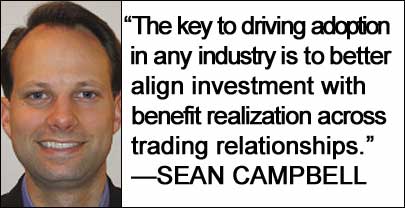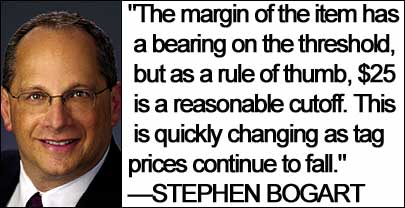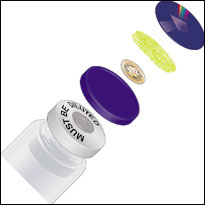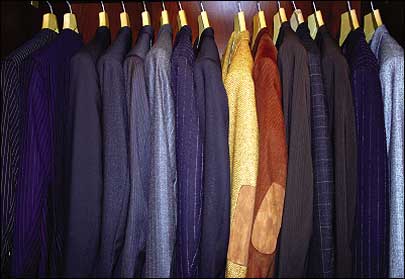Apr 01, 2006Not long ago, the conventional wisdom was that companies would begin deploying radio frequency identification technologies by tracking pallets and cases in the open supply chain. As the volume of tags consumed annually by these applications rose, the price of ultrahigh-frequency RFID tags would fall, and when tags got cheap enough—perhaps 5 cents apiece—companies would begin to put them on individual items. Turns out, conventional wisdom wasn't so wise.
Leading early adopters around the world are aggressively exploring the feasibility of tagging individual items today with an eye to rolling out the technology as soon as it's practical. Rollouts of item-level applications have already begun in several industries. In the pharmaceutical sector, U.S. drug manufacturer Purdue Pharma and others are tagging and tracking individual bottles of pills. German health-care provider Saarbrücken Clinic Winterberg is tracking individual bags of blood. U.S. jeans maker Levi Strauss, Japanese retailer Mitsukoshi, U.K. retailer Marks & Spencer and others are tracking apparel and footwear. Swiss watchmaker and jeweler de Grisogono is tracking watches and diamond rings. And Japanese retailer Yodobashi Camera is tracking individual digital cameras.
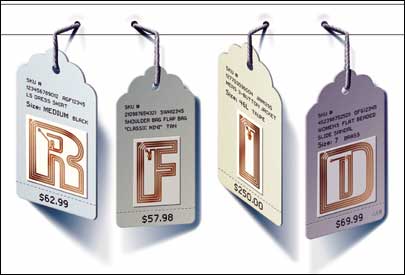
Many more companies are planning item-level tagging pilots. A December 2005 survey of retail managers conducted by AMR Research found that 42 percent of respondents say that item-level tagging will be their organization's most strategically important technology investment over the next 12 to 24 months.
"The interest in item level has risen significantly in the past 12 months and is accelerating," says Elie Simon, CEO of Tagsys, a leading provider of item-level RFID tags.
Robert Locke, CEO of Vue Technology, one of only a handful of RFID vendors focused on item-level tagging, goes even further: "We're seeing an explosion of interest in item-level tagging."
The early thinking about item-level tagging was driven largely by consumer packaged goods companies, which sell low-value, high-volume goods. Item-level tagging was considered to be impractical because the hefty cost of the tags and large numbers of interrogators needed to read them would exceed any potential benefits. CPG companies still say there is no business case for tagging products at the item level, except, perhaps, in special circumstances such as promotions. A 2004 Forrester Research study found that 40 percent of CPG companies surveyed felt they would not begin tagging until at least 2014.
But the apparel, designer goods, pharmaceutical, electronics and entertainment companies, which make high-volume, high-value goods, think otherwise. Early adopters in these industries always knew that the biggest benefits would come from item-level tagging, because that would provide the greatest level of visibility into a company's operations, says Lyle Ginsburg, partner at Accenture. And a number of things have changed in the past eight months or so to make item-level tagging practical and beneficial today.
Companies are more knowledgeable about RFID's capabilities, and early, limited pilots have shown promising results. Tag costs have come down, making the cost of tagging lots of items less prohibitive. The technology is also improving, and RFID hardware and software vendors are introducing new products to help companies tag profitably at the item level (see box below).
Another reason these companies are exploring the possibility of tagging at the item level is they want to leverage the RFID infrastructure they've already installed, says Chris Hook, senior manager at Deloitte Consulting. He points out that early adopters have installed RFID interrogators and related infrastructure to comply with mandates from their customers. They understand the capabilities and limits of RFID systems, and they are looking for ways to leverage that infrastructure for internal benefits. "People are saying, 'OK, where should we use this technology infrastructure to generate business benefits?'" Hook says. "For some companies, that investigation leads to item-level tagging."
One such company is VF Corp., maker of H.I.S., Lee, Riders, Rustler and Wrangler jeans, as well as JanSport backpacks, The North Face outdoor gear and apparel, Nautica sportswear and other brands. VF was among the first wave of companies to tag cases for Wal-Mart. Jim Jackson, director of vendor relationship management at VF, says his company doesn't get any internal benefits from case tagging, because its warehouses have been optimized to take advantage of bar codes and because cases are shipped to Wal-Mart shortly after the jeans the retailer wants have been picked from VF's warehouse shelves.
This year, VF will test how consistently tags can be read on individual items in challenging manufacturing and warehouse environments. It will also explore different applications within its supply chain, such as confirming that the jeans in a box about to be shipped to Wal-Mart are the jeans the retailer ordered.
"We always felt the true value of RFID would be at the item level," Jackson says. "We're in the process of trying to develop pilots that will help us understand the break-even points for doing that. We might learn that we can drive out 10 cents of cost per garment with RFID. With the quantity of tags we need, we'd be at breakeven today. But we need to do the pilots to know what that break-even point is."
Companies are focusing on two key areas: anticounterfeiting and improved on-shelf availability. The military is also looking to track high-value goods, and airplane manufacturers are eager to track individual parts and subassemblies.
Anticounterfeiting
Counterfeiting of high-value products is a big problem, and while no one knows just how big, the Auto-ID Labs has identified the issue as the most challenging problem to a secure supply chain. Tagsys' Simon says companies in the fashion industry are exploring ways to tag designer clothes and accessories, such as handbags, belts and shoes, to reduce counterfeiting. "The fashion industry is very active right now, but you won't hear, see or read much about it," he says. "Companies see this as ammunition against counterfeiters, and they don't want to tip anyone off about what they are doing. But they see RFID as a way to create a certificate of origin and authenticity."
Pharmaceutical companies are also exploring RFID's potential. On Dec. 15, 2005, Pfizer began shipping tagged bottles of Viagra to help distributors and pharmacies determine whether the product is authentic. The company plans to continue shipping tagged Viagra to all its U.S. customers through the end of this year to determine what the benefits are.
Pfizer is using 13.56 MHz tags from Tagsys on its bottles of Viagra. The Electronic Product Code stored on the tag is matched to a 2-D bar code on the product label and stored in a database. Each pharmacy and distributor wishing to authenticate the EPC found on the Viagra RFID bottle tag requires a 13.56 MHz interrogator linked to a computer with Internet access. To authenticate the Viagra it receives, a pharmacy or distributor logs on to a secure business site hosted by Pfizer. Then it reads the EPCs on the shipment of Viagra, and an application from a startup called SupplyScape authenticates them.
Pfizer wants to use this large-scale pilot to deter counterfeiting and assess the performance, acceptance and utility of the technology in the supply chain. "Now that we are shipping tagged product, we need feedback that gives us credible marketplace data as to how tags are performing in the real world, how customers are using the technology and what the benefits are," says Peggy Staver, Pfizer's director of trade product integrity. "That information is critical to us in deciding what we do with this technology beyond the end of 2006."
Fifty percent to 60 percent of respondents in the AMR retail survey think item-level tracking will deliver benefits, including reducing out-of-stocks, shrinkage and labor costs. But more respondents say the biggest benefit to item-level tagging will be in on-shelf availability.
That's not a big surprise. Stores that sell consumer electronics products, apparel, jewelry and other high-value items typically depend on store associates to monitor shelves and/or racks and make sure that items are on the sales floor. Item-level tagging enables companies to have better visibility of what's in the store and where it is. That way, they can move items to where they should be if they're out of place or order more if they're out of stock.
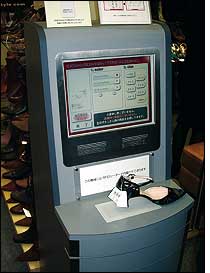
Specialty apparel stores, such as Ann Taylor or Abercrombie & Fitch, keep a lot of merchandise on the selling floor, as well as in the back room and in what's called top stock (racks above the wall shelves). To identify items that are out of stock, store associates need to physically examine the fixtures and shelves and compare what's there with what should be there. "They need to go by memory, and the process is hit or miss in most stores," says Stephen Bogart, RFID strategist at Kurt Salmon Associates, a management consulting firm. "Often, as much as 50 percent of items not represented on the floor are in top stock or back stock, out of reach of the customer."
Item-level tagging lets the store associate take inventory quickly and accurately. Jeff Richards, vice president of intelligent supply chain services at VeriSign, says that projects his company has done with apparel retailers show that it typically takes two people two days to take inventory in stores. At an RFID-enabled store, it takes one person half an hour. As a result, retailers are seeing a 10 percent to 15 percent improvement in sales on items that have been tagged.
Japanese retailer Mitsukoshi, for instance, ran a pilot at a store in Tokyo's Nihonbashi district in which it tracked 6,500 pairs of shoes. During the period of the pilot—October 2004 to February 2005—it saw a 10 percent increase in sales on tagged items. Based on the strength of the pilot, it rolled out the shoe-tagging technology to several stores and has seen sales of tagged shoes rise as much as 20 percent, because of better in-stock availability and because staff can spend more time showing shoes to customers and less time looking for them in the back room. In January, Mitsukoshi launched a pilot in which it tagged designer jeans at its department store in Tokyo's Ginza district.
Best Buy also saw a double-digit increase in sales of Nintendo, Xbox and PlayStation games during a 60-day trial conducted last year. Best Buy outfitted shelves with UHF interrogators using Vue Technology's infrastructure and put tags on the bottom of the games when they arrived at the store. Instead of scanning the shelves for items that were out of stock, staff could go to a computer and print out a report. They would then go to the back room and get the games and restock the shelves. On-shelf availability improved to 98.7 percent, from less than 90 percent. "That's a huge improvement," says Paul Freeman, Best Buy's RFID program director. But he stresses that it's just one store and more tests need to be done to prove RFID will boost sales.
"When the mandates occurred, a lot of people thought RFID would take off more quickly, but there was a lot of resistance to tagging everything in the supply chain," says Kara Romanow, a research director focused on consumer products at AMR Research. "This approach [focusing on specific categories of goods] makes a lot more sense. It's targeted and pragmatic. It addresses pain, and there's an ROI."
While it's talked about less often, RFID is increasingly being looked at as a tool to improve product lifecycle management (PLM) and maintenance. Boeing and Airbus plan to tag high-value parts and subassemblies starting with new planes, such as Boeing's 787 Dreamliner. Boeing wants to use a tag with a lot of memory and write the part's history to the tag and synchronize that with information about the part in a database. That way, engineers and technicians at airport service and repair facilities can remove parts for routine maintenance, write what was done to a part and put it on another plane.
"RFID tagging of individual parts would benefit us in our supply chain," says Daryl Remily, deputy program manager of Boeing's auto-ID program. "But it will also benefit our airline partners by making it easier for them to track parts' histories, and it will benefit consumers because planes will be repaired more quickly and spend less time on the ground."
The U.S. Department of Defense has asked suppliers to put EPC tags on individual items that cost more than $5,000. But the DOD is also seeking to use RFID on items for PLM. The Naval Inventory Control Point (NAVICP), which provides logistics, warehousing, maintenance and other services for the U.S. Navy and Marine Corps, ran a pilot in which it tracked parts from the Al Asad Air Base in Iraq to an NAVICP facility in Norfolk, Va., and from there to a nearby Defense Logistics Agency depot. The goal was to determine the benefits of using RFID to track broken parts more effectively. The final report on the field trial concluded that "passive RFID use at the item and container level has the potential to automate and drive out the deficiencies from several supply chain processes at NAVICP."
In addition, Alan Estevez, deputy undersecretary of defense for supply chain integration for the DOD, says that the DOD wants to track items that have a limited shelf life, such as biochemical warfare suits. The suits contain filters that last for a certain period of time and then must be replaced. Today, it takes a lot of manual tracking to check suits to make sure their filters are still good. RFID tags will be placed on the packaging of suits and other high-value items, but Estevez envisions RFID eventually being embedded in high-value parts and other items to facilitate tracking throughout the product's life.
Tagging at the item level is fundamentally different from tagging pallets and cases. Items are read at close range, are more densely packed when read and require greater security on the tag if they are to be used for anticounterfeiting. The current UHF EPC Generation 2 standard might not be suitable for all item-level applications, so EPCglobal's Hardware Action Group and Business Action Groups set up the Item Level Tagging Joint Requirements Group last year, to spell out the performance requirements that are needed at the item level.
This spring, the item-level subgroup plans to test low-frequency, high-frequency and ultrahigh-frequency tags and interrogators in seven situations in which item-level tags will be used, including on a variety of items in random orientation in a plastic tote and in cases stacked on a pallet. The subgroup will examine the security and privacy requirements of item-level tags and make a proposal to the action groups about the best approach to item-level tagging.
"Our task might be as simple as publishing a set of guidelines about using an existing air-interface protocol, or as complex as creating a new air-interface protocol," says Sue Hutchinson, the facilitator for the item-level tagging subgroup for EPCglobal. "We're not going to know until technology demonstrations are done."
Companies must also overcome some challenges before they launch large-scale deployments for item-level tracking. Perhaps the biggest issue is the cost of buying and deploying handheld and fixed interrogators, shelf antennas and, to a lesser extent, middleware and servers for large-scale deployments. It's one thing to use existing warehouse portal interrogators and a few additional interrogators in a store to run a pilot. It's another do a large-scale rollout. "The cost of the infrastructure has to come down a lot," says AMR's Romanow. "Deploying and maintaining large numbers of readers across several hundred stores is a huge challenge."
The technology also needs to be more reliable and easier to deploy. Tag quality has improved, but end users say that roughly 2 percent of the tags they buy don't work and can't be put on items. And tags can't always be read reliably, though early work with Gen 2 EPC technology suggests that read rates will improve as the new tags hit the market. Interrogators and antennas need to be plug-and-play and easier to deploy and move. "If I move a smart shelf in my store, I can't be dealing with customer antennas, coax cables and power cables," says Best Buy's Freeman. "For us to deploy this across 733 stores, we need readers to be under a couple of hundred dollars. We need them to control antennas on a lot of shelving. We need Power over Ethernet. The cost to retrofit a store is enormous. The good news is, these are things vendors are working on."
Another issue, in some sectors, is who will tag the goods. Apparel companies that manufacture, distribute and sell their own products can benefit from tagging at the source of manufacture. But in the case of DVDs, the manufacturer might have to bear the brunt of the cost while the retailer gets most of the benefits. "The key to driving adoption in any industry is to better align investment with benefit realization across trading relationships," says Sean Campbell, a partner with IBM Business Consulting Services. (Mandates by government regulators or retailers can force suppliers to tag items, which could overcome this obstacle in some industries.)
Manufacturers that aren't forced to tag goods might be willing to, if they get data back from retailers that they can use to improve replenishment, cut inventory and boost sales. For that to happen, says Accenture's Ginsburg, supply chain partners need to agree on standard formats for sharing RFID data. Wal-Mart and Target are sharing data with a few supply chain partners using formats developed by EPCglobal's Fast Moving Consumer Goods Business Action Group. As a result, Hewlett-Packard puts tags on printers shipped to Wal-Mart and uses EPC data supplied by Wal-Mart to prove printers were delivered, reducing invoice deductions. Other industries need to come together and agree on data formats.
No one expects large numbers of companies to tag every item in a store any time soon. Most companies are looking to tag at the item level where it makes sense. Retailers will likely start by tagging specific categories of goods and then expand the number of categories as tags get cheaper and more partners start tagging further back in the supply chain.
"Right now, manufacturers and retailers are working together to find out what the right products to tag are," says Romanow. "They are trying different things to see what makes the most sense, and they are getting closer to finding the answer. The pilots we're seeing now will lead to broad deployments."
In the past year, advances in RFID have made item-level tagging more attractive. Here are some of the recent developments that are having an impact.
Tag prices fall. In September, Alien Technology began selling its Squiggle tags at 12.9 cents each in quantities of 1 million—a 44 percent decrease in the price from a year earlier. Avery Dennison RFID followed with news that it was selling its Gen 1 and Gen 2 inlays, which need to be converted into labels, for 7.9 cents each in similar quantities.
UHF performance improves. The second generation Electronic Product Code air interface protocol has a higher data exchange rate than any previous UHF system. And the tags consume less power so they are read more consistently, which makes it easier, for instance, to quickly interrogate tags on jeans piled on a shelf.
Companies introduce new item-level tags. West Pharmaceutical Services, a manufacturer of vials and caps for injectable drugs, has developed a method of embedding a 13.56 MHz tag from Tagsys in the cap of a drug vial. The cap has a label that identifies the drug and can contain overt and covert anticounterfeiting marks.
In February, Impinj unveiled new, smaller inlays designed for tracking pharmaceuticals, apparel, CDs and DVDs, and other high-value and high-volume products.
The same month, Tagsys rolled out its Adaptive Kernel product line, which consists of a small EPC Gen 2 RFID module, or "kernel" inlay, deployed in conjunction with a secondary, or "adaptive," antenna integrated into packaging. The idea is that millions of kernel inlays can be made cheaply and efficiently and then the secondary antenna, which boosts the read range, can be printed on packaging.
Vendors address infrastructure costs. In December, Vue Technology teamed with Symbol to offer an item-level package that includes Vue's RFID networking technology and EPC management software and Symbol's RFID fixed and handheld interrogators, tags and peripheral devices. Vue's platform enables one interrogator to run hundreds of antennas.
Software applications emerge. Software companies looking to deliver value are introducing applications that use item-level data. SupplyScape has an electronic pedigree application that allows companies to create secure documents that record the chain of custody of individual bottles (or cases) of drugs. Sure ID provides a suite of enterprise applications that use RFID and biometrics to authenticate products and reduce counterfeiting.
If you manufacture, distribute or sell individual products, you might wonder which ones could be tagged profitably today. Lyle Ginsburg, a partner at Accenture, says that one way to approach the task of figuring out the right items to tag is to focus on the highest-value items with the lowest volume and fewest places where you'd need to read them. "You can narrow down your list of items from an economic point of view, and then go from there," he says. "You map these remaining items against the biggest pain points in your industry and then focus on those items."
In the pharmaceutical industry, the burning issue is counterfeiting. In apparel, it's on-shelf availability. In other industries, RFID might help improve customer service, reduce shrinkage, increase patient safety or facilitate maintenance.
Stephen Bogart, RFID strategist at Kurt Salmon Associates, says companies should consider applying tags to items that cost at least $25, given current tag costs of about 15 cents, depending on volume. "The margin of the item has a bearing on the threshold, but as a rule of thumb, $25 is a reasonable cutoff," he says. "This is quickly changing as tag prices continue to fall."
Christopher Hook, senior manager at Deloitte Consulting, advises companies to take a broad view of what's valuable. "If you consider something like blood products, you can't put a price on it," he says, "but it's incredibly valuable because it could save someone's life."
Manufacturers might want to track high-value items that have a short shelf life. Procter & Gamble, for instance, is interested in tracking items during special promotions, because it wants to maximize the return on its marketing dollars by making sure the products are on the shelves when they are being promoted.
Retailers should consider using item-level tagging to improve customer service, says Robert Locke, CEO of Vue Technology. "Customer service gets underplayed because most companies are focused on achieving a short-term ROI," he says. "But if the pharmacist puts a bag on the counter and an RFID system can compare what's in the bag with their prescription, you can reduce your liability and service customers more quickly—and there's a lot of value in that."


